economic evaluation of shale gas reservoir(页岩气资源经济评价)
- 格式:pdf
- 大小:332.94 KB
- 文档页数:10
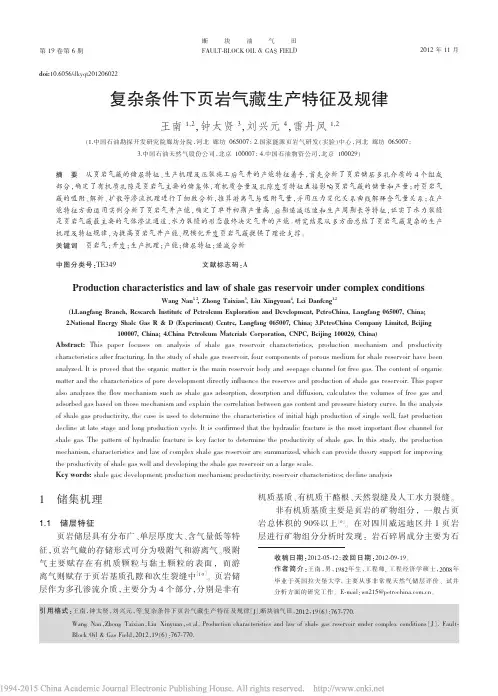
第19卷第6期Production characteristics and law of shale gas reservoir under complex conditionsWang Nan 1,2,Zhong Taixian 3,Liu Xingyuan 4,Lei Danfeng 1,2(ngfang Branch,Research Institute of Petroleum Exploration and Development,PetroChina,Langfang 065007,China;2.National Energy Shale Gas R &D (Experiment)Centre,Langfang 065007,China;3.PetroChina Company Limited,Beijing100007,China;4.China Petroleum Materials Corporation,CNPC,Beijing 100029,China)Abstract:This paper focuses on analysis of shale gas reservoir characteristics,production mechanism and productivity characteristics after fracturing.In the study of shale gas reservoir,four components of porous medium for shale reservoir have been analyzed.It is proved that the organic matter is the main reservoir body and seepage channel for free gas.The content of organic matter and the characteristics of pore development directly influence the reserves and production of shale gas reservoir.This paper also analyzes the flow mechanism such as shale gas adsorption,desorption and diffusion,calculates the volumes of free gas and adsorbed gas based on those mechanism and explain the correlation between gas content and pressure history curve.In the analysis of shale gas productivity,the case is used to determine the characteristics of initial high production of single well,fast production decline at late stage and long production cycle.It is confirmed that the hydraulic fracture is the most important flow channel for shale gas.The pattern of hydraulic fracture is key factor to determine the productivity of shale gas.In this study,the production mechanism,characteristics and law of complex shale gas reservoir are summarized,which can provide theory support for improving the productivity of shale gas well and developing the shale gas reservoir on a large scale.Key words:shale gas;development;production mechanism;productivity;reservoir characteristics;decline analysis1储集机理1.1储层特征页岩储层具有分布广、单层厚度大、含气量低等特征,页岩气藏的存储形式可分为吸附气和游离气。

页岩挥发油井生产分析方法徐兵祥【摘要】生产数据分析方法已广泛应用于页岩油气井,该方法可通过分析生产动态数据,反演求取储层渗透率及裂缝半长等参数,但仅适用于存在一种相态的页岩干气井或页岩油井,应用于在储层及地面均有油气两相产出的页岩挥发油井则存在局限性.通过数值模拟手段,研究不同气油比对特征曲线和解释参数的影响,并提出利用产量折算法进行修正.研究表明:对于页岩挥发油井,仅考虑油相产量会导致均方根曲线斜率变大和线性流特征偏离,且初始气油比越大,线性流特征偏离越明显;同时会导致解释的裂缝半长偏小,实例中解释误差为7%~57%;运用产量折算法可将产气量折算成等质量的油相产量,运用修正后的产油量进行分析可大幅降低裂缝半长解释误差,最大降低幅度为42%.新方法简单便于现场应用,同时可应用于致密油藏.【期刊名称】《油气地质与采收率》【年(卷),期】2016(023)005【总页数】5页(P71-75)【关键词】页岩;挥发油井;生产分析;线性流;产量折算法【作者】徐兵祥【作者单位】中海油研究总院新能源研究中心,北京100028【正文语种】中文【中图分类】TE349近年来,全球掀起了页岩油气勘探开发的热潮[1-3],并在北美率先实现了商业开发。
实践证明,页岩油气产量在较长时间内呈不稳定线性流特征,表现为产油量—时间双对数曲线是斜率为-0.5的直线,学者针对该特点建立了基于线性流的生产数据分析方法[4-11],与Arps[12-13],SEDM[14],Duong[15]等经验或半经验方法不同的是,该方法由理论模型推导得出,并可根据生产数据反求储层参数和控制储量,再进行产量预测。
但该方法模型仅适用于单相油或气流动,北美部分页岩生产区块为油气同产井,如美国鹰滩地区,既有黑油、挥发油,还有凝析气。
笔者对区块挥发油进行生产分析发现,现有理论方法仅考虑了油相产量,而忽略了产气对分析解释的影响。
为解决运用现有方法所造成的误差和如何进一步改进等问题,笔者运用数值模拟手段分析气油比对线性流分析及解释的影响,并提出了改进方法。

一种有效开发致密碳酸盐岩气藏的新工艺——体积酸压李年银;代金鑫;张倩;贾建鹏;隋蕾;朱好阳【摘要】如何对致密裂缝性碳酸盐岩气藏进行有效开发,并使其稳产、高产一直是业界难题.针对这一难题,通过借鉴国外致密油气成功开发的一些研究成果,国内率先提出了针对致密裂缝性碳酸盐岩气藏的体积酸压工艺,经现场应用取得了良好效果.简要阐述了体积酸压的缝网形成机理,通过对比分析,初步明确了鄂尔多斯盆地致密气藏实施体积酸压的可能性;通过岩石脆性评价、裂缝发育及水平主应力差测试、原地应力方位与天然裂缝方位测定、裂缝潜在力学活动性预测、酸岩反应及酸液滤失实验,综合分析了目标气藏实施体积酸压的可行性;并结合现场应用简要阐述了实施体积酸压的原则和思路.最后,针对目前体积酸压实践给出了相关施工建议.该研究成果将推动致密油气藏体积酸压设计理论的发展,加快体积酸压工艺和材料研发速度,提升碳酸盐岩致密油气藏体积酸压优化设计水平,为今后致密油气藏的有效开发提供理论与技术储备.【期刊名称】《科学技术与工程》【年(卷),期】2015(015)034【总页数】12页(P27-38)【关键词】致密油气;致密碳酸盐岩;体积酸压;缝网;鄂尔多斯盆地【作者】李年银;代金鑫;张倩;贾建鹏;隋蕾;朱好阳【作者单位】西南石油大学"油气藏地质及开发工程"国家重点实验室,成都610500;西南石油大学"油气藏地质及开发工程"国家重点实验室,成都610500;中国石油西南油气田分公司天然气研究院,成都610213;中国石油长庆油田分公司苏里格气田研究中心;低渗透油气田勘探开发国家工程实验室,西安710000;中石油冀东油田分公司陆上作业区,唐山063000【正文语种】中文【中图分类】TE371非常规天然气的快速发展为世人所瞩目,对全球的能源格局形成了不容忽视的影响。
作为非常规天然气勘探开发的领跑者,20世纪80年代初,美国非常规天然气勘探开发取得重大突破。
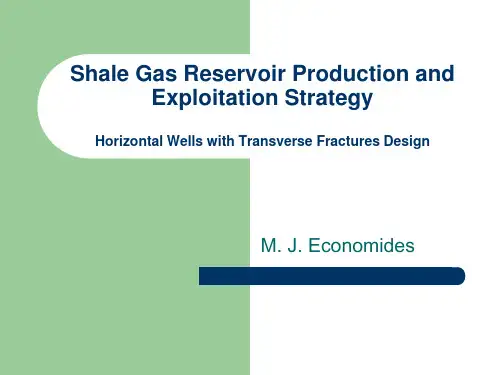
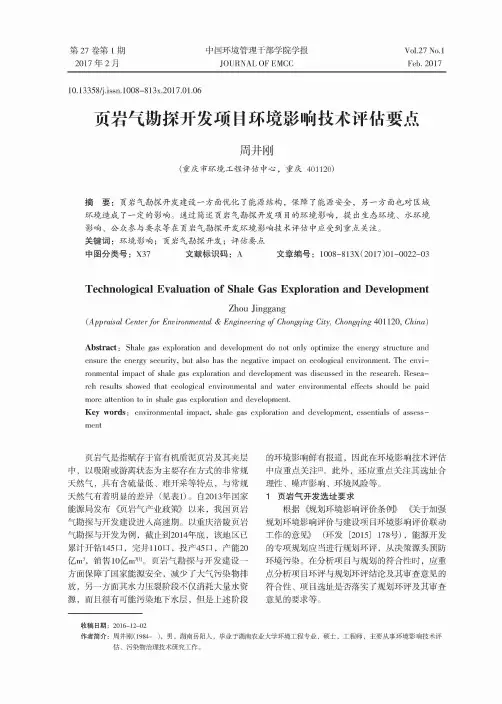
第27卷第1期2017年2月中国环境管理干部学院学报JOURNAL OF EMCC Vol.27 No.1 Feb. 201710.13358/j.issn.1008-813x.2017.01.06页岩气勘探开发项目环境影响技术评估要点周井刚(重庆市环境工程评估中心,重庆401120)摘要:页岩气勘探开发建设一方面优化了能源结构,保障了能源安全,另一方面也对区域 环境造成了一定的影响。
通过简述页岩气勘探开发项目的环境影响,提出生态环境、水环境 影响、公众参与要求等在页岩气勘探开发环境影响技术评估中应受到重点关注。
关键词:环境影响;页岩气勘探开发;评估要点中图分类号:X37 文献标识码:A文章编号:1008-813X(2017)01-0022-03 Technological Evaluation of Shale Gas Exploration and DevelopmentZhou Jinggang(Appraisal Center for Environmental& Engineering of Chongqing City, Chongqing401120, China) Abstract :Shale gas exploration and development do not only optimize the energy structure and ensure the energy security,but also has the negative impact on ecological environment.The environmental impact of shale gas exploration and development was discussed in the research.Research results showed that ecological environmental and water environmental effects should be paid more attention to in shale gas exploration and development.Key words:environmental impact,shale gas exploration and development,essentials of assess-页岩气是指赋存于富有机质泥页岩及其夹层 中,以吸附或游离状态为主要存在方式的非常规 天然气,具有含硫量低、难开采等特点,与常规 天然气有着明显的差异(见表1)。
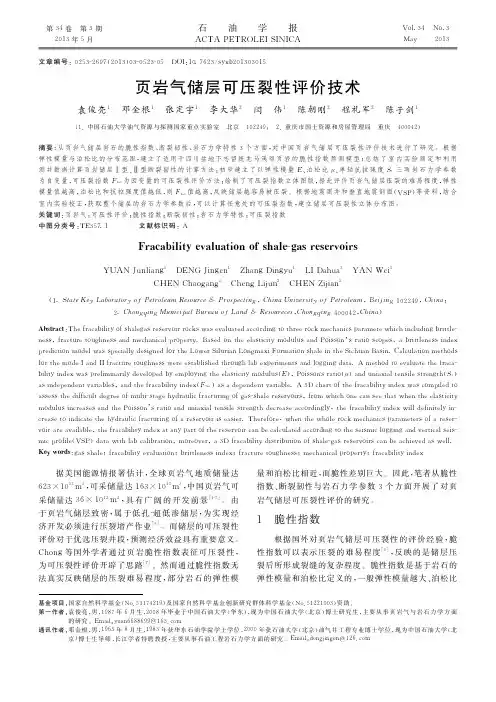
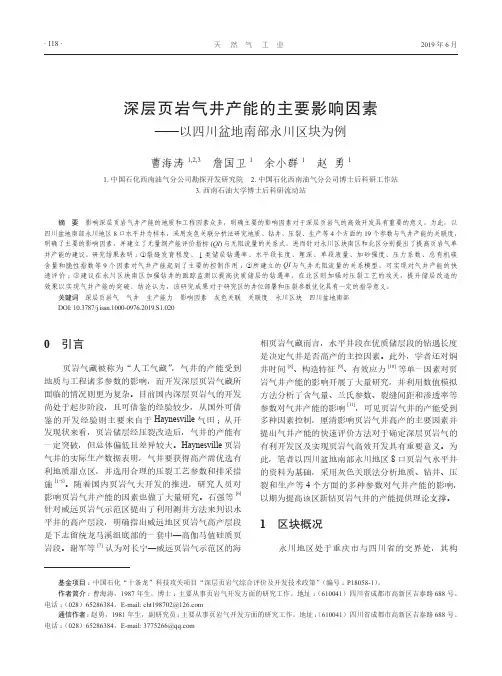
深层页岩气井产能的主要影响因素——以四川盆地南部永川区块为例曹海涛1,2,3 詹国卫1 余小群1 赵 勇11. 中国石化西南油气分公司勘探开发研究院2. 中国石化西南油气分公司博士后科研工作站3. 西南石油大学博士后科研流动站摘 要 影响深层页岩气井产能的地质和工程因素众多,明确主要的影响因素对于深层页岩气的高效开发具有重要的意义。
为此,以四川盆地南部永川地区8口水平井为样本,采用灰色关联分析法研究地质、钻井、压裂、生产等4个方面的19个参数与气井产能的关联度,明确了主要的影响因素,并建立了无量纲产能评价指标(QI )与无阻流量的关系式,进而针对永川区块南区和北区分别提出了提高页岩气单井产能的建议。
研究结果表明:①裂缝发育程度、Ⅰ类储层钻遇率、水平段长度、埋深、单段液量、加砂强度、压力系数、总有机碳含量和脆性指数等9个因素对气井产能起到了主要的控制作用;②所建立的QI 与气井无阻流量的关系模型,可实现对气井产能的快速评价;③建议在永川区块南区加强钻井的跟踪监测以提高优质储层的钻遇率,在北区则加强对压裂工艺的攻关,提升储层改造的效果以实现气井产能的突破。
结论认为,该研究成果对于研究区的井位部署和压裂参数优化具有一定的指导意义。
关键词 深层页岩气 气井 生产能力 影响因素 灰色关联 关联度 永川区块 四川盆地南部DOI: 10.3787/j.issn.1000-0976.2019.S1.020基金项目:中国石化“十条龙”科技攻关项目“深层页岩气综合评价及开发技术政策”(编号:P18058-1)。
作者简介:曹海涛,1987年生,博士;主要从事页岩气开发方面的研究工作。
地址:(610041)四川省成都市高新区吉泰路688号。
电话:(028)65286384。
E-mail:*****************通信作者:赵勇,1981年生,副研究员;主要从事页岩气开发方面的研究工作。
地址:(610041)四川省成都市高新区吉泰路688号。
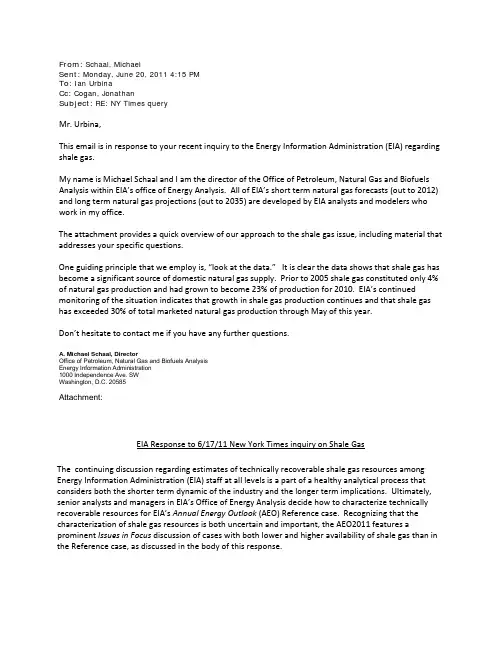
From: Schaal, MichaelSent: Monday, June 20, 2011 4:15 PMTo: Ian UrbinaCc: Cogan, JonathanSubject: RE: NY Times queryMr. Urbina,This email is in response to your recent inquiry to the Energy Information Administration (EIA) regarding shale gas.My name is Michael Schaal and I am the director of the Office of Petroleum, Natural Gas and Biofuels Analysis within EIA’s office of Energy Analysis. All of EIA’s short term natural gas forecasts (out to 2012) and long term natural gas projections (out to 2035) are developed by EIA analysts and modelers who work in my office.The attachment provides a quick overview of our approach to the shale gas issue, including material that addresses your specific questions.One guiding principle that we employ is, “look at the data.” It is clear the data shows that shale gas has become a significant source of domestic natural gas supply. Prior to 2005 shale gas constituted only 4% of natural gas production and had grown to become 23% of production for 2010. EIA’s continued monitoring of the situation indicates that growth in shale gas production continues and that shale gas has exceeded 30% of total marketed natural gas production through May of this year.Don’t hesitate to contact me if you have any further questions.A. Michael Schaal, DirectorOffice of Petroleum, Natural Gas and Biofuels AnalysisEnergy Information Administration1000 Independence Ave. SWWashington, D.C. 20585Attachment:EIA Response to 6/17/11 New York Times inquiry on Shale GasThe continuing discussion regarding estimates of technically recoverable shale gas resources among Energy Information Administration (EIA) staff at all levels is a part of a healthy analytical process that considers both the shorter term dynamic of the industry and the longer term implications. Ultimately, senior analysts and managers in EIA’s Office of Energy Analysis decide how to characterize technically recoverable resources for EIA’s Annual Energy Outlook (AEO) Reference case. Recognizing that the characterization of shale gas resources is both uncertain and important, the AEO2011 features a prominent Issues in Focus discussion of cases with both lower and higher availability of shale gas than in the Reference case, as discussed in the body of this response.While resource estimates will continue to be updated as new information become available, experience suggests that EIA has been more likely to understate rather than overstate the contribution of unconventional oil and natural gas resources in recent AEO Reference cases.Annual Energy OutlookEvery year, EIA develops the AEO based on the best available data regarding energy resources, supply technologies, consumption determinants, and prices. As part of this AEO effort, EIA uses a variety of public sources to develop data used in EIA energy models, for example, shale gas well production profiles, costs, and resources by shale formation. These data sources include, but are not limited to, the following sources:∙HPDI for individual well production data∙Lippman Consulting for shale gas production by shale formation∙INTEK, Inc. which collected publicly available shale gas well production profiles and well costs.INTEK also developed shale gas resource estimates for specific shale gas formations that currently under development (e.g., Barnett, Haynesville, Marcellus), based on both estimated shale gas well recovery rates (derived from well production profiles) and shale formation acreage.∙U.S. Geological Survey for resource estimates regarding shale formations that are not currently under development and for which there is no well drilling, production, or cost history∙Oil and gas company presentations that provide shale gas well production profiles and costs, and∙Press reports on company acreage, acreage costs, well production profiles and costs.The assumptions regarding shale gas resources currently being used as the basis of EIA’s Reference case projections are consistent with estimates of technically recoverable resources from a wide range of academic and industry experts. EIA uses contractors to supply critical expertise in resource assessment for regions and resource categories where development activities undertaken since the last available resource assessments by government agencies have added significant new knowledge about resources. This longstanding EIA practice has been applied for resources other than shale gas, including tight sands gas, shale oil, and enhanced oil recovery. EIA's procurement of contractors for this and other purposes conforms with all applicable federal rules and policies.EIA’s development of the projections and alternative cases for the AEO are documented and made available within the AEO itself, a paper outlining key assumptions1 and the model documentation.2 In1 Available on the EIA website at /oiaf/aeo/assumption/oil_gas.html2 Available on the EIA website at /analysis/model‐documentation.cfmaddition, the process that we used to develop the underlying model structure itself is, and remains, an open process as documented on our website.3The AEO oil and gas supply models undergo continuous modification and improvement based on new information regarding drilling and production technologies, and the ability and cost of developing oil and gas resources using those technologies. The resource recovery and cost of recovery associated with a specific well cannot be fully ascertained until that well is plugged and abandoned.The Annual Energy Outlook 2011 (AEO2011) acknowledges this uncertainty surrounding shale gas resources and the cost of developing them in the AEO2011 Issues in Focus analysis entitled: “Prospects for Shale Gas.”4 We invite your attention to that section, which was developed in order to understand those issues. That analysis notes that “there is a high degree of uncertainty around the (AEO2011 reference case) projection, starting with the estimated size of the technically recoverable shale gas resource. Estimates of technically recoverable shale gas are certain to change over time as new information is gained through drilling and production, and through development of shale gas recovery technology.” The article then delineates 5 specific uncertainties associated with shale gas resources and costs. The analysis goes on to discuss 4 alternate case projections, which double and halve the resource base and the shale gas production cost per well. The variation in alternate case assumptions is consistent with the degree of resource variability shown in USGS shale gas resource assessments. Across the 4 alternate shale gas cases, considerable variation is projected in domestic shale gas and total natural gas production, natural gas imports, natural gas prices, and natural gas consumption.One issue that is directly incorporated into EIA’s modeling is the steep declines in production from shale gas wells. EIA assesses the current and potential future decline curves for shale gas and other natural gas production by reviewing the well‐level data available from HPDI as well as other sources. An aggregate representation of how shale gas decline curves impact shale gas production is shown in Figure 1. The figure shows the model result of how the relatively large first‐year declines of wells drilled, combined with the decline in production from the all other wells in production results in an increasing amount of gas that must be replaced each year before further growth can be achieved. Our analysis and modeling shows, given all the information gathered and reviewed to date, that such production can be achieved within the time frame of the projection.3 Available on the EIA website at /oiaf/emdworkshop/model_development.html in the section describing the development of the Onshore Lower 48 Oil and Gas Supply Submodule (OLOGSS)4 Available on the EIA website at /forecasts/aeo/IF_all.cfm#prospectshaleFigure 1. Projection of U.S. Shale Gas Production by VintageInternational Shale Gas Resource AssessmentEIA’s recent report, World Shale Gas Resources: An Initial Assessment of 14 Regions Outside the United States , was developed to explore the issue of whether other countries have geological opportunities similar to the Unites States to develop shale gas. The report is intended to be a starting point in addressing that question. Above ground issues were not considered within the report. During the development of the report, bi ‐weekly conference calls were held with other offices within DOE as well as other government agencies to review and comment on draft chapters as they were developed by the contractor. We believe that the report stands on its own merits as we required the contractor to fully document all work and to clearly describe the methodology that was employed to produce the estimates. We welcome any substantive comments on the technical merits of the report.The Shale Gas Industry: Short TermThere have been numerous discussions within EIA about whether the major production increases over the past several years are sustainable from an economic perspective. Included in these discussions are debates about lease costs, the costs of production, the decline rates and ultimately recoverable resources from shale wells, the price of natural gas, the price of natural gas liquids, and the price of crude oil.Notwithstanding the sharp decline in natural gas prices since mid ‐2008, there are a number of factors that have prevented a significant slowdown in production growth up to the present time, some of which are likely to continue:4812200920142019202420292034∙Some producers have been active hedgers and, therefore, may not immediately respond to price declines with reduced production. Companies can continue to lock in prices that may limit their profit potential if prices rise quickly but also shield them from further declines that would make their short term business plans untenable.∙Lease terms often stipulate that production must begin within a number of years or the lease becomes void. Producers who purchased leases are sometimes motivated to drill in order to secure the lease for the future. According to trade press reports, this behavior has been a factor over the past year, particularly in the Haynesville shale. There are indications that this type of drilling is winding down as producers secure their leases.∙The major price differential between natural gas, natural gas liquids (ethane, butane, propane, etc), and crude oil means that a low natural gas price can be overcome by drilling in “wet” plays – areas such as parts of the Eagle Ford and Marcellus shales with high liquid or crude oil content. Some analysts estimate that natural gas in these plays can be sold at low prices while still maintaining a profitable well because of the high price of those liquids.∙Joint ventures from international partners have provided major infusions of cash to companies in the United States and Canada. These partners, who could be interested in expanding the use of new drilling technology overseas at some point in the future, may focus on gaining technical experience and technology associated with shale drilling in addition to the value of hydrocarbon production.。
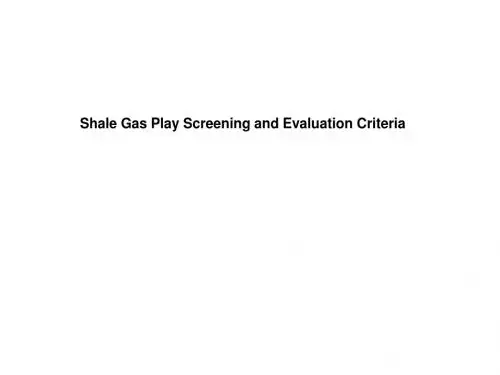
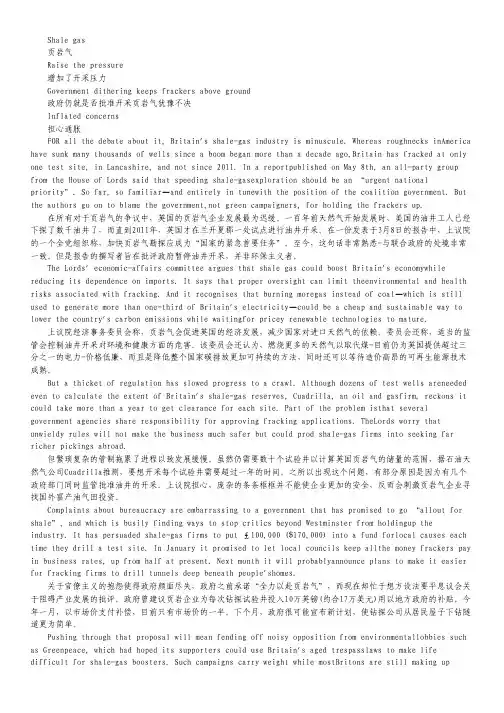
Shale gas 页岩气 Raise the pressure 增加了开采压力 Government dithering keeps frackers above ground 政府仍就是否批准开采页岩气犹豫不决 Inflated concerns 担心通胀 FOR all the debate about it, Britain's shale-gas industry is minuscule. Whereas roughnecks inAmerica have sunk many thousands of wells since a boom began more than a decade ago,Britain has fracked at only one test site, in Lancashire, and not since 2011. In a reportpublished on May 8th, an all-party group from the House of Lords said that speeding shale-gasexploration should be an “urgent national priority”. So far, so familiar—and entirely in tunewith the position of the coalition government. But the authors go on to blame the government,not green campaigners, for holding the frackers up. 在所有对于页岩气的争议中,英国的页岩气企业发展最为迟缓。
一百年前天然气开始发展时,美国的油井工人已经下探了数千油井了,而直到2011年,英国才在兰开夏郡一处试点进行油井开采。
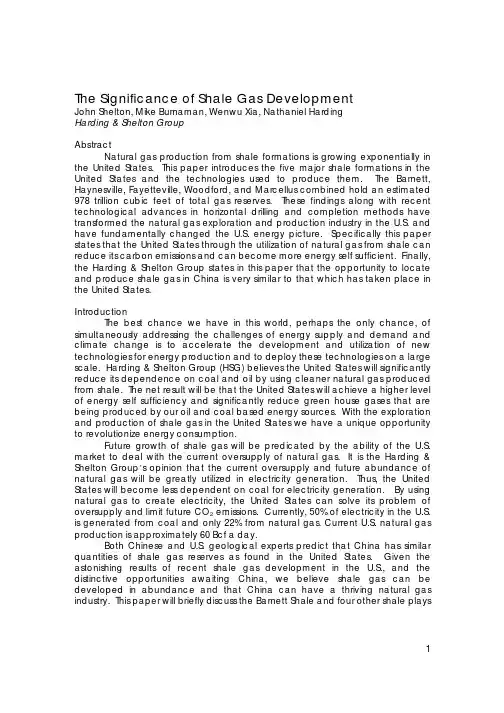
The Significance of Shale Gas DevelopmentJohn Shelton, Mike Burnaman, Wenwu Xia, Nathaniel HardingHarding & Shelton GroupAbstractNatural gas production from shale formations is growing exponentially in the United States. This paper introduces the five major shale formations in the United States and the technologies used to produce them. The Barnett, Haynesville, Fayetteville, Woodford, and Marcellus combined hold an estimated 978 trillion cubic feet of total gas reserves. These findings along with recent technological advances in horizontal drilling and completion methods have transformed the natural gas exploration and production industry in the U.S. and have fundamentally changed the U.S. energy picture. Specifically this paper states that the United States through the utilization of natural gas from shale can reduce its carbon emissions and can become more energy self sufficient. Finally, the Harding & Shelton Group states in this paper that the opportunity to locate and produce shale gas in China is very similar to that which has taken place in the United States.IntroductionThe best chance we have in this world, perhaps the only chance, of simultaneously addressing the challenges of energy supply and demand and climate change is to accelerate the development and utilization of new technologies for energy production and to deploy these technologies on a large scale. Harding & Shelton Group (HSG) believes the United States will significantly reduce its dependence on coal and oil by using cleaner natural gas produced from shale. The net result will be that the United States will achieve a higher level of energy self sufficiency and significantly reduce green house gases that are being produced by our oil and coal based energy sources. With the exploration and production of shale gas in the United States we have a unique opportunity to revolutionize energy consumption.Future growth of shale gas will be predicated by the ability of the U.S. market to deal with the current oversupply of natural gas. It is the Harding & Shelton Group’s opinion that the current oversupply and future abundance of natural gas will be greatly utilized in electricity generation. Thus, the United States will become less dependent on coal for electricity generation. By using natural gas to create electricity, the United States can solve its problem of oversupply and limit future CO2 emissions.Currently, 50% of electricity in the U.S. is generated from coal and only 22% from natural gas. Current U.S. natural gas production is approximately 60 Bcf a day.Both Chinese and U.S. geological experts predict that China has similar quantities of shale gas reserves as found in the United States. Given the astonishing results of recent shale gas development in the U.S., and the distinctive opportunities awaiting China, we believe shale gas can be developed in abundance and that China can have a thriving natural gas industry. This paper will briefly discuss the Barnett Shale and four other shale playsin the United States, new technologies being employed, and the significance of future shale gas production in China.United States Shale Gas DevelopmentShale gas development is a growing source of natural gas production in the United States. Unlike conventional gas plays, shale gas plays are expansive, lower risk, yield predictable yet marginal results and extend across the continental U.S. The Barnett Shale of the Fort Worth Basin is the most successful play to date both in natural gas production and in its innovation of newer techniques of horizontal drilling and completion practices. These practices have become a model for the development of other shale plays.The distribution of shale formations in the continental United States with estimated reserves is shown in (Figure 1). The Barnett Shale has set the standard for shale gas development. Since 2004 production has grown from 1 Bcf a day to over 4 Bcf a day (see Figure 2). The Fayetteville, Haynesville, Woodford, and Marcellus are expected to show similar or possibly greater production and reserve growth as exhibited in the Barnett.Gas production from shale has grown from less than 70 Bcf per year in the late 1970s to over 7.5 Bcf a day in 2008. The majority of growth has been achieved through the exploration and development of the five shale plays shown in table 1, of which an estimated 5 Bcf a day comes from the Barnett Shale.Five Major Shale Gas Plays in United States 516 tcf25-75 tcf 17 tcfBarnettThe recent success of the Barnett Shale has caused many operators to use this play as an analog for exploration and development. The history of the play reveals the impact of technology and how the oil and gas industry overcame challenges to unlock the resource potential and improve recovery factors. Figure 2 shows the development history for the Barnett play using annual gas production and producing well count. The play was quietly developed by one operator in the early 1980s through the mid-1990s using vertical well technology. Major horizontal development began in 2004. As of 2008, over 10,000 wells have been drilled, and two thirds of them are horizontal wells.The Mississippian Barnett Shale in the Fort Worth Basin is the most active natural gas play in the United States (Figure 1). Activity levels in the Barnett Shale have increased dramatically since 2000, from 190 completions to over 1,750 completions in 2008. Production per year has also increased significantly over this same time period, growing from 80 Bcf in 2000 to over 1,500 Bcf in 2008.Figure 2: Barnett Shale Production (based on data from PI Dwights as of August 2008) Total organic content (TOC) is approximately 4.5% with the total porosity between 4-5%. The Barnett Shale extends across most of the Fort Worth Basin and is located at depths ranging from 6,500 feet to 8,500 feet. The Barnett has a shale thickness from 100 to 600 feet. Estimated reserves per well in the Barnett are 2.2 Bcf. The initial estimated daily production per well is 2.7 Mmcf. Estimated reserves are 75 trillion cubic feet of gas (see Table 1).The Barnett play will continue to evolve and expand through drilling and application of new technologies to overcome challenges in new and existingareas of the basin. In doing so, operators are gaining a greater understanding of better approaches and techniques as well as accelerating the learning curve and increasing the chance of better success in new plays.HaynesvilleDevelopment in the Haynesville gas play began in late 2007. Current natural gas production exceeds 500 million cubic feet a day from approximately 100 wells. The Haynesville is an Upper Jurassic formation overlain by the Cotton Valley Group, and lies over the Smackover Formation. The Haynesville shale is located in northwest Louisiana and East Texas, particularly in Caddo, Bossier and DeSoto Parishes, but also to a lesser extent in Red River and Sabine Parishes, and Harrison and Panola Counties (see Figure 1). Deeper than most shale gas plays, the Haynesville is located at depths ranging between 10,500 and 13,500 ft.Shale thickness is estimated at 200-300 feet or more in the better areas. The TOC in the Haynesville play is between 0.5-4.0 % with a total porosity around 8-9%. Estimated reserves per well in the Haynesville are 4.5 Bcf. The initial estimated daily production per well is 6 Mmcf. Estimated reserves are 350 trillion cubic feet of gas (Table 1). The Haynesville is currently believed to be potentially the most prolific producing shale play in the United States.WoodfordThe Devonian Woodford Shale of the Arkoma Basin is also one of the newer plays to emerge with significant drilling activity and production. The focus of the emerging play is in southeastern Oklahoma in Hughes, Pittsburg and Coal Counties (Figure 1). Intensive horizontal development of the Woodford play began in 2004. At the end of 2008 gross daily production had grown to an estimated 900 mcf a day. Gross thickness of the Woodford Shale ranges from 120 to 220 feet. Depth to the Woodford in the active area ranges from 6,000 to 11,000 feet. The total organic content in the Woodford play is between 1.0-14.0 % with a total porosity around 3-9%. Natural fractures and high silica content contribute to the success of the Woodford shale play. Estimated reserves per well in the Woodford are 3 Bcf. The initial estimated daily production per well is 3.5 Mmcf. Estimated reserves are 20 trillion cubic feet of gas (Table 1). FayettevilleThe Mississippian Fayetteville Shale of the eastern Arkoma Basin is another new play to emerge and already has significant drilling activity and production. The play is being developed in the Arkansas portion of the Arkoma basin (Figure 1). Drilling first began in 2003 and current production is around 1.1 Bcf a day. The play is developing in a depth range of slightly less than 3,000 feet deep to over 7,000 feet. Gross thickness of the productive section ranges from 20 to 200 feet. The total organic content in the Fayetteville play is between 4.0-9.8 % witha total porosity around 2-8%. Estimated reserves per well in the Fayetteville are2.5 Bcf. The initial estimated daily production per well is 2.5 Mmcf. Estimated reserves are 17 trillion cubic feet of gas (Table 1).MarcellusThe Marcellus Shale is part of a large suite of rocks known as the Devonian shales, and stretches NE-SW about 600 mi across several Appalachian states, including New York, Pennsylvania and West Virginia. The naturally fractured, dry gas-producing Marcellus covers an area of about 95,000 square mi, and ranges in thickness from 50 to 200 ft. Like the Fayetteville, the Marcellus thins from east to west, with 200-ft sections in northeastern Pennsylvania and 50-ft sections in northern West Virginia, Ohio, Pennsylvania and western New York. The formation depth ranges from 4,000 to 8,500 ft. The TOC in the Marcellus play is between 3.0-12.0 % with a total porosity around 10%. Estimated reserves per well in the Marcellus are 2 Bcf. The initial estimated daily production per well is 2.5 Mmcf. Estimated reserves are 516 trillion cubic feet of gas (Table 1). The estimated reserves are higher in the Marcellus than any other play due in part to its large geographical area.Table 1 presents a comparison of the characteristics of the five shale gas plays in the U.S including: estimated reserves play size, production volumes, and depth to production zone.Gas Shale Basin Barnett Marcellus Fayetteville Haynesville Woodford Estimated BasinArea, square miles5,000 95,000 9,000 9,000 11,000Depth, feet (ft) 6,500-8,500 4,000-8,5003,000-7,000 10,500-13,5006,000-11,000Net Thickness, feet(ft)100-600 50-200 20-200 200-300 120-220Total OrganicCarbon %4.5 3.0-12.0 4.0-9.8 0.5-4.0 1.0-14.0 Total Porosity % 4-5 10 2-8 8-9 3-9Gas-In-Place, Tcf 250 2,500 52 1050 66 Reserves, Tcf 75 516 17 350 20 Estimated InitialGas Production,mcf/day/well2,700 2,500 2,500 6,000 3,500Estimated AverageReserves per well,Bcf2.2 2.0 2.5 4.53.0Table 1: Characteristics of five shale gas plays in the U.S (Adapted from Authur et al, 2008).ImplicationsNatural gas production from shale formations is growing exponentially in the United States, increasing from less than a billion cubic feet a day in 1998, to。
作者简介王英(1980-),女,山东泰安人,工程师,就职于山东泰山矿产资源检测研究院。
国内页岩气分析测试技术评价方法王英,赵仕华,宁曙光(山东泰山矿产资源检测研究院,山东泰安271000)摘要目前全球范围的页岩气开发已经展开。
页岩气开发的第一步是了解页岩的特性,只有通过对页岩储层进行详细的勘探评价,充分了解页岩储层特征,找出有利的页岩气勘探开发区域,才能进行页岩气的商业性生产,因此页岩气分析测试技术评价方法体系的建立为页岩气的勘探开发提供有力的依据。
本文叙述了中国页岩气5大体系:(1)岩石学分析体系;(2)地球化学分析体系;(3)含气性分析体系;(4)等温吸附实验;(5)特殊岩心分析体系。
关键词页岩气实验体系评价技术中图分类号P618.130.2文献标识码Edoi :10.3969/j.issn.1005-2801.2013.06.48Test Evaluation Methods of Domestic Shale GasWang YingZhao Shi-huaNing Shu-guang(Shandong Taishan Institute of Mineral Resource Test&Research ,Taian 271000,China )AbstractShale gas is globally developing.The key for shale gas development id to understand the characteristics ofshale ,only through exploration and evaluation of shale reservoir ,we fully understand the shale reservoir characteristics and find out the exploration and development of shale gas favorable region ,to the commercial production of shale gas.Therefore ,shale gas analysis to establish the evaluation method of system testing technology provides the powerful basis for exploration and development of shale gas.This paper describes China s shale gas 5system :(1)petrology analysis system ;(2)the system analysis of the geochemical ;(3)analysis system of gas ;(4)the isothermal adsorption experiment ;(5)special core analysis system.Key wordsshale gasexperimental systemevaluation techniques页岩气是指以热成熟作用或连续的生物作用为主以及两者相互作用生成的、聚集在烃源岩中的天然气,在主体上包括了游离态(存在于天然裂缝与粒间孔隙中)、吸附态(存在黏土矿物颗粒、干酪根颗粒表面)和溶解态(存在于干酪根和沥青质中),基本上包括了天然气存在的所有可能相态[1]。
review of shale gas sorption and its models -回复什么是页岩气吸附及其模型?为什么对页岩气吸附进行研究是重要的?如何进行页岩气吸附研究?什么是吸附模型?目前存在哪些页岩气吸附模型?这些模型的优缺点是什么?如何选择适合的模型进行页岩气吸附研究?接下来,我们将一步一步回答这些问题。
第一部分:什么是页岩气吸附及其模型?页岩气吸附是指天然气在页岩储层中通过物理吸附作用与岩石表面相互作用并被固定住的过程。
随着页岩气的发现和开发,研究页岩气吸附及其模型变得越来越重要。
页岩气吸附模型是一种数学表达式或数学模型,用来描述和预测页岩气在岩石中吸附的程度。
这些模型通常基于气体分子在固体表面上的吸附和解吸过程及动力学规律,包括吸附等温线和吸附等温线。
第二部分:为什么对页岩气吸附进行研究是重要的?研究页岩气吸附对于评估和预测页岩气资源量、储层特性和开发潜力至关重要。
了解和预测页岩气在岩石中的吸附行为,可以帮助石油工程师更好地设计和开发页岩气储层,提高气田开发效率。
同时,研究页岩气吸附还对环境保护具有重要意义。
了解和控制页岩气在地下储层中的吸附行为,可以减少环境上对水资源和土壤的污染风险。
第三部分:如何进行页岩气吸附研究?进行页岩气吸附研究需要进行实验室实验和数据分析。
实验室实验可以通过一系列的吸附实验,如等温吸附实验和脱附实验,来测量和分析页岩气在不同条件下的吸附量和解吸量。
数据分析是通过处理实验数据并应用数学模型来揭示吸附行为的特征和规律。
通常,研究者会对实验数据进行统计分析和拟合,以获得吸附模型的参数和吸附等温线。
第四部分:什么是吸附模型?吸附模型是一种用数学表达式或数学模型来描述和预测吸附等温线的工具。
吸附等温线是描述吸附剂吸附介质上吸附剂浓度与介质中吸附剂浓度之间关系的曲线。
吸附模型通常基于理论、实验或经验,并在吸附研究中被广泛应用。
它们可以用来量化吸附剂在不同条件下的吸附能力,并预测吸附等温线。
公共课英语一模拟题2020年(37)(总分80, 做题时间180分钟)Section Ⅰ Use of EnglishDirections:Read the following text. Choose the best word(s) for each numbered blank and mark A, B, C or D on ANSWER SHEET.. After a racist massacre by a white gunman in a church in Charleston, South Carolina, Mr Obama **forted black America as no other president could. And he has been a voice of 1 . America, he has 2 people, **e a long way on race; those who think it has not should listen to blacks who lived through the 1950s, 1960s or 1970s. But he also notedthat 3 inequalities remain.Mr Obama first soared to fame, more than a decade ago, with a speech decrying those who would divide the country into black and white Americas. He was right to do so, but that is not the end ofthe 4 . In general the state should be colour-blind, but the police cannot do their job well 5 they make extra efforts to forge links of trust with **munities, and schools should pay 6 attention to groups who flounder (苦苦挣扎).Sensibly, Mr Obama does not talk about financial reparationsfor past injustices, and is not interested in assigning blame for racial gaps. 7 he talks of promoting equalityof 8 , through such painstaking but vital things as early-childhood education, reading schemes, apprenticeships at **panies and mentoring to spot young men when they are firstdrifting 9 trouble. His most immediate answerto 10 poverty is a proposal to expand the earned-income tax credit, doubling the maximum credit for a childless worker to $1,000 a year and increasing the income level at which it is phased out. This is a good idea: such wage subsidies not only lift people ( of all races) out of 11 ; they also encourage them to work, which is the 12 to social mobility.Racial ills that 13 over centuries will notbe 14 in the last 18 months of Mr Obama's presidency. Meanwhile, Americans can **fort from the 15 in public opinion that the Charleston massacre 16 . Itis 17 recalling that when Klansmen bombed black churches in the deep South in the 1960s, the police barely 18 to investigate. This time the killer was 19 caught. As with gay marriage, attitudes have changed 20 , and for thebetter. Mr Obama's presidency is both a reminder of that progress and an opportunity to accelerate it.SSS_SINGLE_SEL1.•**•**•****A AB BC CD DSSS_SINGLE_SEL2.•**•**•****A AB BC CD DSSS_SINGLE_SEL3.•**•**•****A AB BC CD DSSS_SINGLE_SEL4.•**•**•****A AB BC CD DSSS_SINGLE_SEL 5.•**•**•****A AB BC CD DSSS_SINGLE_SEL 6.•**•**•****A AB BC CD DSSS_SINGLE_SEL 7.•**•**•****A AB BC CD DSSS_SINGLE_SEL 8.•**•**•****A AB BC CD DSSS_SINGLE_SEL 9.•**•**•****A AB BC CD DSSS_SINGLE_SEL 10.•**•**•****A AB BC CD DSSS_SINGLE_SEL 11.•**•**•****A AB BC CD DSSS_SINGLE_SEL 12.•**•**•****A AB BC CD DSSS_SINGLE_SEL 13.•** up•** up•** up** upA AB BC CD DSSS_SINGLE_SEL 14.•**•**•****A AB BC CD DSSS_SINGLE_SEL 15.•**•**•****A AB BC CD DSSS_SINGLE_SEL 16.•**•**•****A AB BC CD DSSS_SINGLE_SEL 17.•**•**•****A AB BC CD DSSS_SINGLE_SEL18.•**•**•****A AB BC CD DSSS_SINGLE_SEL19.•**•**•****A AB BC CD DSSS_SINGLE_SEL20.•**•**•****A AB BC CD DSection Ⅱ Reading Comprehension Part ADirections:Read the following four texts. Answer the questions after each text by choosing A, B, C or D. Mark your answers on ANSWER SHEET. Text 1. In 1815 William Smith published a map of British geology that, by identifying coal deposits, helped kick-start the Industrial Revolution. Exactly 200 years later, as the government tries to put more puff into the economy's sails, it is hoping for a similar boost from another source of hydrocarbons: shale gas. Progress is being made, but painfully slowly, and there is still plenty of opposition to **e.Hydraulic fracturing, or "fracking", has been used before in Britain but never to extract shale gas. The process uses water and chemicals to split rocks deep underground and extract the gas. A group of MPs sought to impose a moratorium (暂停,暂禁) on the process, but they were defeated in a parliamentary vote on January26th. The government undercut them by assenting to a ban on fracking in national parks and to new regulations that will make fracking harder: one, for example, will **panies to monitor fracking sites for a year before drilling.Different geology, higher population density and a more international gas market mean shale in Britain is unlikely to be the game changer it has been in America, where gas prices have plunged. But extracting onshore shale gas could make up for the decline in North Sea gas and make Britain less dependent on unreliable, distant suppliers. No wells have been drilled since a ban was lifted in 2012, however.Before this week's debate, a **mittee had warned that drilling for shale gas was "incompatible" with Britain's climate-change targets, even though the Committee on Climate Change, thegovernment's official advisers, said shale gas (which is cleaner than coal) can help slow global warming. "Certainly we need to cutreliance on carbon fuels," says Quentin Fisher, an expert at Leeds University, "but in the meantime we need to become more self-reliant." On January 28th the Scottish government announced its own moratorium on fracking.Professor Fisher says people have exaggerated the dangers. Drilling a well is noisy and disruptive, but after a few weeks only a building the size of a garden shed remains. "People may change their minds," he says, "once they see how safe it is."They might not see anything for a while. Cuadrilla, an **pany, has applied to drill for shale gas in Lancashire, but this has been held up by local objections. On January 28th the county council deferred its final decision. Even if this application isunsuccessful, however, others are likely to succeed. Says Professor Fisher, "I have no doubt that wells will be drilled in the next few years."SSS_SINGLE_SEL1. The author mentions the case of William Smith to indicate that ______.•** was the person who launched the Industrial Revolution•** government tries to find a way to promote economy•** made clear the real reserve of British coal deposits** has proved very difficult to find new sources of energyA AB BC CD DSSS_SINGLE_SEL2. A group of MPs' attempt to impose a moratorium ______.•** to win the approval of Parliament•** frustrated in the former vote•** to gain support for fracking** to be completely futileA AB BC CD DSSS_SINGLE_SEL3. It can be inferred from the 3rd paragraph that ______.•** gas will change the outcome of game in Britain•** of shale gas has proved successful in America•** gas extraction has lowered the gas prices in Britain** gas has made Britain less dependent on foreign suppliersA AB BC CD DSSS_SINGLE_SEL4. Professor Quentin Fisher argues that ______.•** turn blind eyes to the risks concerning shale gas.•** involved in well drilling have been underestimated.•** gas drilling can cut Britain's reliance on carbon fuels.** for shale gas will not bring about too many hazards.A AB BC CD DSSS_SINGLE_SEL5. It seems that the author's attitude towards shale drilling in Britain is ______.•**•**•****A AB BC CD DText 2. The idea that certain businesses are so essential that they must not discriminate between customers is as old as ferries. With only one vessel in town, a boatman was generally not allowed to charge a butcher more than a carpenter to move goods. This concept, called "common carriage", has served the world well, most recently on the Internet. The principle of blindly delivering packets of data, regardless of origin, destination or contents, is welded into the network's technical foundations. This, more than anything else, explains why the Internet has become such a fountain of innovation.Yet with the Internet becoming more crowded and traffic-management tools improving, this principle-known today as "network neutrality"-is under threat. **s firms would like to create lanes of different speeds, not just to manage their networks better, but to capture more profits. Internet advocates fear this would lead to an online world studded with toll booths and other chokepoints. Theyfret that rent-seeking network operators would abuse their market power. Prices would shoot up for those using the fast lanes; everyoneelse would get much cheaper, but much crummier, service.Governments are taking action. However, finding a solution has proved tricky. First, neutrality is a slippery concept. Although the Internet was designed to treat all data equally, it was **pletely neutral: services such as games or video have always been at a disadvantage because the public Internet cannot guarantee real-time connections. Second, any reform involves legal quandaries. After losing several American court cases because the Internet was held to be an unregulated information service, America's Federal Communications Commission (FCC) wants to reclassify it as an old-style utility in order to impose network-neutrality rules.The debate is, therefore, unlikely ever to end. Better to stick with broader rules, such as insisting that a provider's basic broadband service cannot be much slower than the fast lanes it offers—and ensure that regulators and the public can police them. Each operator should be required to publish detailed information about its network's performance. Regulators should have the power to punish those underhand tactics.Wherever possible, however, they should leave the market tosort things out. The best way to do this is to encourage **petition in all parts of the Internet, particularly between broadband providers, so that none can become a bottleneck and exploit that position. Get rid of those monopolies and there would be much less need to worry about the mind-numbing intricacies of network neutrality.SSS_SINGLE_SEL1. The concept of "common carriage" may apply to all of the following EXCEPT ______.•** should not be allowed to different customers•** essential businesses are not bound by this principle•** concept might constitute the basis of network technology** should be delivered on the net whatever they might beA AB BC CD DSSS_SINGLE_SEL2. Internet advocates worry that abandoning "network neutrality" may ______.•** rise to worse service for fast-lane users•** to higher price for all network users alike•** birth to unfairness to some customers** result in mismanagement of networksA AB BC CD DSSS_SINGLE_SEL3. Governments' action to ensure "network neutrality" may be difficult because ______.•** operators could easily abuse their market power•** of speech would be infringed by legal regulations•** FCC intends to reclassify the old-style utility of Internet ** is no clear-cut and legal criterion to the conceptA AB BC CD DSSS_SINGLE_SEL4. In the 4th paragraph, the author seems to call for ______.•** regulations to guarantee basic network service•** to investigate the performances of providers•** operators to share their secrets with the public** broadband service to be the same as the fast lanesA AB BC CD DSSS_SINGLE_SEL5. It can be inferred from the last paragraph that ______.•** must be got rid of completely•** cannot exploit their power•** need to worry about neutrality** mechanism should play its roleA AB BC CD DText 3. After months of debate, having exhausted all the alternatives, the European Central Bank (ECB) announced that it was finally introducing a big programme of quantitative easing. QE—creating money to buy financial assets including sovereign bonds—was first used by the Bank of Japan in the early part of the 2000s; the Federal Reserve and the Bank of England introduced it in the wake of the financial crisis of 2008. Long-standing German antipathy to the policy, however, has made the ECB a late adopter.The central bank is turning to QE because of the enfeebled state of the European economy. The recovery has been weak and faltering. Financial markets no longer believe that the ECB will be able to get inflation back to its goal of nearly 2% over the medium term. Its previous efforts to stimulate the economy, which include becoming the first big central bank to impose negative interest rates, have been inadequate.Financial markets were unfamiliar with the new measure when it was introduced in America and Britain. As a result it brought down yields sharply. By contrast, the markets have long been expecting the ECB to introduce QE. That has already led to a remarkable rally in sovereign-bond markets. Therefore the effect of implementing QE will be limited.Another difference between QE in the euro zone and in Americain particular arises from the nature of their financial systems. Because firms rely much more heavily on capital markets in America, they benefited a lot as falling yields on government debt pushed investors into riskier assets such as corporate bonds. By contrast, banks are more dominant in the euro zone, so **panies will benefit less from the boost to European capital markets.There are two main channels through which QE is likely to work in the euro zone. One is the "signalling" effect. By adopting the policy, the ECB is sending a clear message to markets and to firms that it is determined to bring inflation closer to 2%. The other is through the exchange rate. The euro has already been weakening since last spring. Further weakening of the single currency seems likely.All this makes the ECB's foray into QE less like the programmes launched by the Fed and the Bank of England at the height of the crisis and more like those of the Bank of Japan. As with Japan'srecent bond-buying splurge (乱花钱,挥霍), the main effect seems likely to come via the exchange rate. The worry is that like Japan in the early 2000s, the ECB may be introducing the policy too late.SSS_SINGLE_SEL1. From the first paragraph, we may infer that ______.•** has always followed suit after US and Japan•** has long been against resorting to QE•** has proved to be futile in other countries** of England has been hand in hand with ECBA AB BC CD DSSS_SINGLE_SEL2. It can be learned from the passage that ECB turned to QE ______.•** a result of the gloomy economic situation•** negative interest rates are unacceptable•** that it can't expect to eliminate inflation** recovery has reached its planned levelA AB BC CD DSSS_SINGLE_SEL3. The effect of QE in the euro zone will not be obvious as in America ______.•** to the readiness of firms to buy corporate bonds•** European markets are unfamiliar with the measure•** investors rely too heavily on government debt** to the difference between their financial systemsA AB BC CD DSSS_SINGLE_SEL4. If QE is to work in the euro zone, ______.•** has to send a signal in advance•** will have to adopt a new policy•** weakening of euro is under way** rate should remain stableA AB BC CD DSSS_SINGLE_SEL5. A conclusion about ECB's programme of QE can be drawn from the passage that ______.•** will continue to oppose the implementation of the policy •** effect will be immediate and profound as in other countries •** policy will help, but less so than in other big economies** has never brought about expected effects all over the worldA AB BC CD DText 4. Everyone had assumed that his job was on the line, but the swiftness of the departure of Don Thompson, chief executive of McDonald's, came as a surprise. On January 28th the world's biggest fast-food chain announced that Mr Thompson will leave on March 1st. He will be replaced by Steve Easterbrook, the chief brand officer.The abrupt **es after one of the worst years in McDonald's recent history. On January 23rd **pany announced its first annual drop in "like-for-like" sales (after stripping out the effect of opening new outlets) since 2002. In the last quarter of 2014 operating profit had fallen 20% compared with the same quarter in the previous year. On a conference call on the day the results were announced, Mr Thompson said **pany faced "meaningful headwinds" and was "acting with a sense of urgency".Institutional shareholders had grown frustrated, and were presumably bending ears on the board, well before those ugly numbers were unveiled. Activist investors had started to circle. To what extent they played a role in pushing Mr Thompson out is unclear, butthey would have moaned about the huge opportunity cost of holding McDonald's shares, which are worth less now than they were in early 2012, whereas the market has gone up 50%.Turning around the supertanker of the restaurant business will not be easy. Especially in its home market the firm's customers are confused by the nearly 200 choices on its menu, suspicious of the ingredients and preservatives in its food and enraged by the way it seems to treat its workers.Some analysts wonder whether Mr Easterbrook, as a longtime insider, is the fresh blood needed at the top of McDonald's. But he has a good track record: he turned around the firm's fortunes in Britain, his home country, now one of McDonald's best-performing markets, after becoming boss of the local operations in 2006. According to Will Slabaugh, an analyst at Stephens, a financial-services firm, the change at the top is an indication of the firm's willingness to shake up the menu at the cheaper end, refranchise a majority of the restaurants still owned by **pany (more than 80% are franchised) and add debt to an under-leveraged balance-sheet to return cash to shareholders.Winning back customers' trust, particularly in America where McDonald's operates 14,200 of its 35,000 outlets, will take time. Yet it can be done: McDonald's had a grotty image in Britain before Mr Easterbrook took over there. Can the man from Watford, north of London, manage to repeat this feat in his adopted country?SSS_SINGLE_SEL1. It can be inferred from the first paragraph that Don Thompson______.•** been expected to quit sooner or later•** later than had been expected•** take place of Easterbrook's role** staged a surprising performanceA AB BC CD DSSS_SINGLE_SEL2. It can be inferred from the passage that ______.•**'s is now experiencing the first annual drop in history•** company's operating profit has fallen 20 percent as a whole •** might exert some pressure on Don Thompson's quit**'s shares are worth 50% less now than they used to beA AB BC CD DSSS_SINGLE_SEL3. In its home market, McDonald's seems to ______.•** the favor of its customers•** less choices than overseas•** a better record than abroad** dissatisfaction by its tacticsA AB BC CD DSSS_SINGLE_SEL4. According to the passage, Steve Easterbrook is chosen to replace Mr Thompson ______.•** he is the fresh blood needed•** to his former success in Britain•** no one else dares to face the challenge** to the support of institutional shareholdersA AB BC CD DSSS_SINGLE_SEL5. It can be concluded from the passage that ______.•**'s no easy job to turn around McDonald's gloomy business•**'s will have to shut down a majority of its outlets•** Easterbrook is sure to repeat his feat as in Britain** will get more cash than they used toA AB BC CD DSection Ⅲ TranslationDirections:Translate the following text from English into Chinese. Write your translation on ANSWER SHEET.1. In German eyes, strong exports and a big trade surplus are symbols of economic virility. But foreigners are more impressed with Germany's recent employment record. A decade ago Germany had one of the worst jobless rates in the rich world. Today its unemployment rate of 5.4% (using OECD figures) is one of the lowest in Europe. Youth unemployment, below 8%, is half that in America and a third of the European average. It is also the lowest Germany has seen for 20 years.This is not the result of booming growth. Over the past decade Germany's economy has on average grown more slowly than America's and Britain's and barely faster than that of the euro zone as a whole. But Germany managed to avoid a surge of lay-offs after the financial crisis and has done far better than others at getting the young and the hard-to-employ into work.SSS_TEXT_QUSTISection Ⅳ WritingPart B1. Directions:In your writing, you should1) interpret the chart and2) give your **mentsYou should write at least 150 words.Write your essay on ANSWER SHEET.2018年某市市民消费付款方式的情况SSS_TEXT_QUSTI1。
review of shale gas sorption and its models -回复Shale gas sorption is a critical process that affects the extraction and production of unconventional natural gas from shale formations. It involves the adsorption of methane and other hydrocarbon gases onto the surface of organic matter and inorganic minerals within the shale matrix. Understanding shale gas sorption is crucial for accurately estimating the gas storage capacity and evaluating the commercial viability of shale gas reservoirs. Over the years, numerous studies have been conducted to investigate shale gas sorption and develop models that can predict sorption behavior. In this article, we will review the current state of knowledge on shale gas sorption and discuss the different models used to describe the sorption process.Shale gas sorption is influenced by several factors, including the composition and properties of the shale rock, the pressure and temperature conditions, and the chemical nature of the gases involved. The main mechanism responsible for sorption is the Van der Waals forces acting between the gas molecules and the surface of the sorbent. The Langmuir and Freundlich isotherm models are commonly used to describe the equilibrium sorption behavior ofshale gas.The Langmuir model assumes that the sorption process occurs on a homogeneous surface with a fixed number of active sites available for adsorption. It predicts that the amount of gas adsorbed increases linearly with the pressure until a maximum adsorption capacity is reached. The Freundlich model, on the other hand, is empirical and describes sorption as a multilayer adsorption process with a variable distribution of adsorption energies. It allows for a wider range of sorption behaviors compared to the Langmuir model.Both the Langmuir and Freundlich models have been applied extensively to describe the sorption behavior of methane and other hydrocarbon gases in different shale formations. However, it is important to note that the assumptions made by these models may not always accurately reflect the complex nature of shale gas sorption. Hence, researchers have also developed more advanced models to capture the intricacies of the sorption process.One such model is the Dual Mode Langmuir model, which considers the presence of both Langmuir and Freundlich sorptionsites. This model has been found to better fit experimental data from shale samples compared to the traditional Langmuir model. Similarly, the BET (Brunauer-Emmett-Teller) model, commonly used to describe gas adsorption on solid surfaces, has been modified to account for the heterogeneity of shale surfaces and the multilayer sorption behavior.In addition to these empirical models, there have been efforts to develop molecular-scale models that can provide insights into the sorption mechanisms at a microscopic level. Molecular dynamics simulations and Monte Carlo simulations have been used to study the interaction between gas molecules and shale surfaces, allowing for a more detailed understanding of the sorption process. These models take into account factors such as surface roughness, mineralogy, and gas composition, providing a more accurate representation of the sorption behavior.Despite the advancements made in modeling shale gas sorption, there are still several challenges to overcome. The heterogeneous nature of shale rocks, the complex interactions between gas and rock surfaces, and the lack of comprehensive experimental data make it difficult to develop universally applicable models.Furthermore, the practical application of these models for estimating gas storage and recovery in shale reservoirs remains a subject of ongoing research.In conclusion, shale gas sorption is a complex process that plays a crucial role in the production and extraction of unconventional natural gas. The development of accurate and reliable sorption models is essential for estimating gas storage capacity and evaluating the commercial viability of shale gas reservoirs. While empirical models such as the Langmuir and Freundlich models have been widely used, more advanced models taking into account the heterogeneity of shale surfaces and the molecular-scale interactions are being explored. Continued research and experimental validation will enhance our understanding of shale gas sorption and enable more accurate predictions for the exploitation of shale gas resources.。
CRI英语听力2012年08月合辑(文本):Shale-Gas-an-Energy-Game-changerThe Chinese government has attached increased importance to developing its natural gas supply, including its domestic unconventional gas reserves – shale gas.The National Energy Administration or NEA has unveiled a plan to explore and test new technologies to unlock its shale gas reserves.CRI's Su Yi has more.China's natural gas consumption has exploded over the last decade, due to increasing demands for cleaner energy resources.Burning natural gas produces about half as much greenhouse gas pollution as other fossil fuels such as coal and oil.China's shale gas reserves are estimated at 25 trillion cubic meters, one of the world's largest.The assumed abundance of shale gas has led to sweeping changes in future gas projections.Shale gas is popularly called a "game-changer" in the United States and is currently one of the fastest growing energy sources.Vignesh Gowrishankar, a sustainable energy scientist of the United States Natural Resource Defense Committee or NRDC, says natural gas can bridge the gap between fossil fuels and renewable energies."Natural gas provides an inexpensive, cleaner fossil fuel until renewable energy becomes cheap enough to be deployed widely. So that's one point. The second point is, renewable energy sources, such as wind and solar energy, still suffer from being used intermittently. "Shale gas extraction has been practiced in the US since the mid-20th century, but it was not until the last decade that production became commercially viable.The period before commercial shale gas production scales up is an invaluable opportunity for China to learn from US experiences.Briana Mordick, an oil and gas scientist at the NRDC, explains the driving force behindshale gas development."Shale gas development in the United States was driven primarily by declining production of conventional gas and technological advances, advances in horizontal drilling and hydraulic fracturing, and the ability to combine these two techniques."According to Yang Fuqiang, an expert in energy and climate change, 70 percent of China's energy supply comes from coal, which has brought in severe environmental and coal mine safety problems.Shale gas, as a substitute energy source, can efficiently solve those problems.However, the extraction of shale gas can also have adverse impacts on the environment and on human health ranging from water contamination, air pollution and land disturbances, among others.Considering those problems and impacts, Yang suggests that the Chinese government give priorities to companies working on new energy source projects."Firstly, the price index is essential. Investors will join in only when they think the gas price is profitable. This is an important encouraging policy. A second incentive policy lies in tax preferences. Because of the high standards for drilling techniques, investment in shale gas is usually larger than other forms of resources. Thirdly, banks can lend low interest loans to the investors."China plans to derive 10 percent of its primary energy consumption from natural gas by 2020, among which shale gas will account for 5-10 percent.For CRI, I'm Su Yi.。
收稿日期:2023-10-26;修订日期:2023-12-29。
作者简介:熊康(1999—),女,在读硕士研究生,现从事非常规石油地质与勘探研究工作。
E-mail:1689611244@qq.com。
文章编号:1673-8217(2024)02-0082-06昭通地区五峰组-龙马溪组页岩气储层分级综合评价熊 康1,2,张凤生3,谭玉涵3(1.西安石油大学地球科学与工程学院,陕西西安710065;2.西安石油大学陕西省油气成藏地质学重点实验室,陕西西安710065;3.中国石油集团测井有限公司,陕西西安710077)摘要:建立完善的页岩气储层评价体系对指导非常规页岩气勘探开发具有重要意义。
根据昭通地区五峰组-龙马溪组常规测井资料,构建页岩气储层关键参数地质评价模型;采用层次分析法完成页岩气储层的可压性计算,并建立基于可压性分级的储层工程评价模型;然后结合地质评价与工程评价双重因素,构建页岩气储层综合评价模型,并利用实测压裂射孔资料进行验证分析。
结果表明,综合评价较好的Ⅰ类储层产气量较高;采取水平井分段分簇设计,可达到提高压裂产能效率的目的。
所构建的储层综合评价模型能够系统而有效地开展对页岩气储层的评价,可为昭通地区页岩气储层勘探提供借鉴。
关键词:页岩气;地质评价;工程评价;评价参数;层次分析法;压裂射孔中图分类号:TE122 文献标识码:AComprehensiveevaluationofshalegasreservoirclassificationofWufengFormation-LongmaxiFormationinZhaotongareaXIONGKang1,2,ZHANGFengsheng3,TANYuhan3(1.SchoolofEarthSciencesandEngineering,Xi’anShiyouUniversity,Xi’an710065,Shaanxi,China;2.ShaanxiKeyLaboratoryofPetroleumAccumulationGeology,Xi’anShiyouUniversity,Xi’an710065,Shaanxi,China;3.CNPCLoggingCo.,Ltd.,Xi’an710077,Shaanxi,China)Abstract:Asoundshalegasreservoirevaluationsystemisimportantforguidingunconventionalshalegasexplorationanddevelopment.BasedonconventionalloggingdatafromWufeng-LongmaxiFormationinZhaotongarea,ageologicalevaluationmodelforkeyparametersofshalegasreservoirsisconstructed.Thecompressibilityofshalegasreservoiriscalculatedbytheanalytichierarchyprocess(AHP),andthereser voirengineeringevaluationmodelbasedonthecompressibilityclassificationisestablished.Then,combinedwithgeologicalevaluationandengineeringevaluation,acomprehensiveevaluationmodelofshalegasreser voirisconstructed,andtheactualfracturingperforationdataisusedtoverifyandanalyze.Theresultsindi catethatClassⅠreservoirswithbetterevaluationhavehighergasproduction.Adoptingasegmentedandclustereddesignforhorizontalwellscanimprovefracturingproductivityefficiency.Theconstructedreservoircomprehensiveevaluationmodelcanevaluateshalegasreservoirs,whichprovidesagoodreferenceforshalegasreservoirsexplorationinZhaotongarea.Keywords:shalegas;geologicalevaluation;engineeringevaluation;evaluationparameters;analytichier archyprocess;fracturingperforation 页岩气在世界范围内分布广泛。
SPE 119899Economic Evaluation of Shale Gas ReservoirsJohn D. Wright, SPE, Norwest CorporationCopyright 2008, Society of Petroleum EngineersThis paper was prepared for presentation at the 2008 SPE Shale Gas Production Conference held in Fort Worth, Texas, U.S.A., 16–18 November 2008.This paper was selected for presentation by an SPE program committee following review of information contained in an abstract submitted by the author(s). Contents of the paper have not been reviewed by the Society of Petroleum Engineers and are subject to correction by the author(s). The material does not necessarily reflect any position of the Society of Petroleum Engineers, its officers, or members. Electronic reproduction, distribution, or storage of any part of this paper without the written consent of the Society of Petroleum Engineers is prohibited. Permission to reproduce in print is restricted to an abstract of not more than 300 words; illustrations may not be copied. The abstract must contain conspicuous acknowledgment of SPE copyright. AbstractThree 9-square mile areas in the Newark East Field were studied to investigate the economic viability of the Barnett shale gas play. The areas chosen corresponded to the 25th, 50th, and 75th percentiles based on average estimated ultimate recovery per well in the areas. The actual drilling and refrac schedule was used for each area along with actual and forecasted production and today’s costs and prices to calculate economics on the 329 wells in the areas. Most of the individual wells are not economic under the assumptions of this study. Of the three areas, only the 75th percentile area was economic when considered as a whole. The results are most sensitive to capital costs and gas prices.IntroductionGas shale plays are the current rage in the U.S. oil and gas industry. At the present time major gas shale plays are unfolding in the Barnett, Woodford, New Albany, and Fayetteville shales and other basins are being targeted as well. The most mature of these plays is the Barnett shale near Fort Worth Texas with more than 6000 wells on production. The most mature field in this play is the Newark East Field located primarily in Wise and Denton counties, Texas. This field was “discovered” in 1981 and rapid drilling began in the late 1990s. There is now enough production history to begin to develop an idea of how commercial these plays can be. As with any emerging resource play, there have been a number of changes in drilling and completion practices over the years. Major advances in technology include drilling horizontal wells, re-fracing existing wells, and using slick water for frac jobs. Rather than attempting to quantify the effects of those technological changes, this study examines the economics of the Barnett play as it was actually developed.Study MethodologyThe Barnett gas shale in the Newark East Field was studied by subdividing the field into 3-mile x 3-mile blocks. The average estimated ultimate recovery (EUR) for each 3 x 3 block was determined from a proprietary database containing EUR’s for approximately 4500 Barnett shale wells. This database was created by using decline curve analysis to estimate remaining reserves for each “event” on each well. “Events” subsequent to initial production are usually assumed to be refracs, but may include significant increases in production from other effects. Figure 1 shows the production rate from an example well along with the decline curve extrapolations. A bubble map of the average EUR for each block which contains more than 20 wells is shown in Figure 2. Figure 3 contains a cumulative frequency plot of EUR for those blocks. It can be seen that the cumulative frequency curve is almost linear, indicating that the average EUR’s for the blocks appear to be approximately uniformly distributed. Three blocks were chosen for more detailed study. These blocks correspond roughly to the 25th, 50th, and 75th percentile as shown by the large dots on Figure 3 and the black, red, and blue dots on Figure 2. Each of these study areas contains more than 100 wells. The study areas will be referred to as the “Low”, “Medium” and “High” areas in the remainder of this paper.For the purposes of this study the timing of the wells, the choice of horizontal or vertical wells, and the refracing was modeled exactly as it occurred. Actual production was used as long as it was available and the extrapolation of the final “event” was used to project future production. Obviously, these assumptions limit the applicability of the study results to new plays where different technology might be employed from the start. It also does not take into account potential refracs or recompletions or increased density drilling in the future in the three areas. However, in spite of these limitations, it is instructive to look at the economics of these areas based on historical timing and technology.119899 2 SPEEconomics were run for each individual well and summed to arrive at “project” economics using “base case” assumptions forprices and costs. This is equivalent to assuming that a company holds a 9-section area and develops it with approximately100 wells. Sensitivity runs were made to determine the effects of a 25% change in prices, capital costs, and operating costs.An additional sensitivity run was made in each area to examine the effect of the top 5% of the wells on the projecteconomics.Production ForecastFigures 4, 5, and 6 show a “project” production history and forecast on a semi-log plot along with the vertical and horizontalwell count and the number of refracs on a Cartesian plot. The historical production and forecast for each area is compared inFigure 7. While a quantitative comparison cannot be made, it is interesting to note that the Low Area has primarily verticalwells with few refracs, the Medium Area has primarily vertical wells with many refracs, and the High Area has about twiceas many horizontal wells as vertical wells and few refracs.Economic ParametersThe economics were run on an individual well basis and summed for each area. The base case economic parameters areshown in Table 1 and were chosen to represent an approximation of current conditions. The cases were run on a before-income-tax basis and the net cash flows were discounted back to time zero (the date of first production for each of theindividual areas) at 10% per annum.Base case runs were made for each area. Sensitivity runs were also made for each area by individually varying price, capitalcosts, and operating costs 25% higher and lower than the base case values. An additional sensitivity run was made byremoving the top 5% of the wells in each area from the analysis. A total of 24 different runs were made.ResultsBase CaseThe EUR’s for the wells ranged from about 50 MMCF to about 6 BCF with most of the wells being below 1 BCF. Figure 8shows the cumulative frequency of EUR (for the base case economic assumptions) for each of the three areas. In the LowArea, 90% of the wells are less than 1 BCF. In the Medium Area, 60% of the wells are below 1 BCF, and even in the HighArea about 50% of the wells are less than 1 BCF. All of the areas show a wide variation in EUR; between 1 and 2 orders ofmagnitude. On an undiscounted basis, the EUR necessary to pay out the well or just recover the capital cost ranges fromabout 550 MMCF to 900 MMCF as shown in Figure 9. There is an excellent correlation between EUR and undiscounted netcash flow (sometimes called NPV0) as shown in Figure 10, a “zoomed-out” version of Figure 9.A number of managerial indicators were calculated including undiscounted net cash flow, time to payout, net present value,discounted profit to investment ratio, and internal rate of return. Discounted profit to investment ratio (DP/I) will be used tocompare the different areas. For the purposes of this paper, DP/I is calculated by dividing the net cash flow discounted at10% by the investment stream discounted at 10% and adding 1. This is equivalent to dividing the discounted net operatingincome by the discounted investment. The “hurdle” value is therefore 1.0. A project or well that has a DP/I of 1.0 has a netpresent value (NPV) of zero at 10%. That means it has a 10% internal rate of return. For the assumptions in this study thereis a strong correlation between internal rate of return and DP/I as shown in Figure 11. Using the assumptions in this study,including the shape of the production profile, a DP/I of about 1.25 results in an internal rate of return of about 20%. Asignificant number of wells had internal rates of return that were less than zero, i.e., the wells never paid out.The economics for individual wells in the three areas can be compared by examining a cumulative frequency plot of DP/I asshown in Figure 12. Assuming a DP/I hurdle of 1.0, 50% of the wells in the High Area, 65% of the wells in the MediumArea, and 90% of the wells in the Low Area are uneconomic. The results on a total project (area) basis are a DP/I of 0.54 forthe Low Area, 0.90 for the Medium Area, and 1.24 for the High Area. That means that if each of the areas were a project,one project would be a dismal failure, one would be a mild economic failure, and one would be a reasonable, but notoutstanding, economic success. Successful refracs in the future will help the economics somewhat from those presented here.Sensitivity CasesThe sensitivity cases are presented on an area basis. The results are contained in Table 2. The input variable with the mostimpact on DP/I is the capital cost. A 25% decrease in capital costs results in a 44% to 72% increase in DP/I. A 25% increasein gas price results in a 28% to 34% increase in DP/I. As usual, operating expense has little effect on full cycle economicswith a 25% change in operating costs making a 3% to 9% change in DP/I. Production profile has the largest effect, however.A 25% decrease in capital costs or a 25% increase in prices will not, by themselves, make the Low Area economic.However, changes of those magnitudes will cause the Medium Area to become economic. The fragile nature of these typesof plays is illustrated by the effect of a price decrease or cost increase on the High Area. A 25% decrease in price or a 25%increase in capital costs will cause even the High Area to become uneconomic.SPE 119899 3 The top 5% of the wells are very important to the overall economic viability of the projects. If the top 5% of the wells were not discovered then the DP/I would be 0.48 instead of 0.54 for the Low Area, 0.83 instead of 0.90 for the Medium Area, and 1.10 instead of 1.24 for the High Area. In that scenario, the High Area becomes somewhat marginal as a project. Considering that the High Area represents the 75th percentile of the entire field this has large implications for the development of the play.Conclusions1.There is wide range in EUR’s and, according, a wide range in economic value for individual wells in the Barnettshale play.2.At today’s costs and prices it takes an ultimate recovery of about 550 to 900 MMCF to pay out a well.3.Based on the economic assumptions used in this paper, 226 of the 389 wells studied (69%) had less than a 10%internal rate of return.4.At today’s costs and prices the 25th percentile areas based on EUR are not economically viable, the 50th percentileareas are almost economically viable, and the 75th percentile areas are reasonably economically viable.5.Discounted profit to investment ratio is very sensitive to capital costs and gas prices and much less sensitive tooperating costs.6.In any given area, the top 5% of the wells based on ultimate recovery have a significant effect on the economicviability of the project.4 SPE119899Table 1 – Economic ParametersCapital CostsVertical Well Drill & Compl. $2,400,000Vertical Well Refrac $ 600,000Horizontal Well Drill & Compl. $3,400,000Horizontal Well Refrac $1,000,000Operating Cost 6000 $/well/monthAsof Date Varies by AreaDisc Rate 10% /AnnumWorking Interest 100%Net Revenue Interest 85%Severance Tax Rate 7.5%Ad Valorem Tax Rate 3.0%BTU/SCFBTU 1000Shrinkage 0Net Back Wellhead Gas Price $7 /MMBTUTable 2 – Results of sensitivity cases on discounted profit to investment ratioDiscounted Profit to Investment Ratio (DP/I) @ 10%AreaArea HighArea MediumLow-25% Base +25% -25% Base +25% -25% Base +25%Price 0.36 0.54 0.72 0.62 0.90 1.18 0.89 1.24 1.59Capex 0.91 0.54 0.35 1.55 0.90 0.59 1.79 1.24 0.93Opex 0.58 0.54 0.49 0.96 0.90 0.85 1.29 1.24 1.20Figure 1 – Production history and forecast for an example well.SPE 119899 5 Figure 2 – Bubble map of average EUR for all wells in a 3-mile by 3-mile block with study areas highlighted4Bl Low (25th Percentile) AreaMedium (50th Percentile) AreaFigure 3 – Cumulative frequency of average EUR with study areas highlighted119899 6 SPEFigure 4 - Production history and forecast, wellcount, and refrac count – Low (25th percentile) AreathSPE 119899 7 Figure 6 - Production history and forecast, wellcount, and refrac count – High (75th percentile) Area119899 8 SPEFigure 8 – Cumulative frequency of EUR for each of the three areasSPE 119899 9 Figure 10 – Correlation between EUR and undiscounted net cash flow10 SPE119899 Figure 12 – Cumulative frequency of individual well DP/I for each area。